Hello Desert Soldiers !!
Today, let's get to know details of one of the versions of the famous 3-ton British Bedford 4x4 truck. It is a specialized version that has evolved from being a transport to being almost a self-propelled artillery, an improvised destroyer for fighting in the African desert. Most interestingly, when this theater of operations was conquered, this fighting girl returned to her origins, being readapted and built as a transport again. We're talking about Bedford QL 6 pr. gun portee.
 |
| Bedford QL 6 pr gun portte The vehicle does not have the gun in its cargo bay. source: REME Museum |
History:
The creation of an anti-tank vehicle on wheels was one of the idealized options to meet the need for greater mobility and flexibility for the Army's anti-tank artillery, in the fluid (excuse the pun ...) war in the desert. The selection criteria for this weapon would be the use of a robust, 4x4 vehicle, high reliability, with good load capacity and preferably, which was in full production, to accelerate the development and production of the project. The use of the 3-ton Bedford QL chassis and its cousins was practically a consequence in itself.
 |
| Bedford QL 4x4 3 ton restored |
The idea of carrying a gun, rather than just towing it, was not a new concept, being tested for the first time in WWI.
 |
| Thornycroft J Type and 13pdr AA gun WWI - 1915. |
 |
| Thornycroft J Type and 13pdr AA gun The Imperial War Museum in Duxford, England |
One of the biggest problems with a towed weapon was its vulnerability and lack of maneuverability. A weapon mounted on the vehicle could, in military terminology, 'shoot and flee'. The Ordnance Quick-Firing 6-pounder gun or just 6 pounder gun was selected as the main weapon of the project. The gun could be towed, but it was much more commonly carried, there being three different ways to do this. In fighting trim, the gun could be mounted so as to fire off forwards over the canvas-top cab.
 |
Bedford QL Portee with 6pdr unloaded, crossing a captured location in Tunisia (source: British Pathe newsreel) |
To achieve this, various preparations had to he made: importantly, the radiator had to be protected of the explosion blow through the gun nozzle and a large anti-blast plate was provided for this purpose. Firing-off this way also necessary to fold the top and sides of the canvas cabin, as well as the windshield. With the gun in this position, the front axle weight was 3,900 kg and the rear axle's 3,400 kg, making up the total gross weight, with the gun, of 7,300 kg. Luckily, Bedfords chassis had always been famous for their capacity to accept an overload, as their nominal maximum gross weight was 7,100 kg.
The anti-tank gun could also be mounted to fire off rearwards. In this configuration, the cab top and sides could be left intact. The vehicle could be driven with the gun in either of the fighting positions but, for really going places, the 'touring trim' was used, with the gun out of action, facing forward over the cab.
 |
| 6-pdr anti-tank gun in action in the Western Desert 29 October 1942. |
The 6-pounder was loaded and off-loaded using two hand-winches. The gunwheel and central trail ramps which were used when winching the gun aboard after changing positions from forward to rearward firing off - thankfully a task which did not have to be performed all that often - were carried in a locker beneath the body floor. At the rear, a steel superstructure suppor led a detachable canvas tilt inside which were four, demountable, tip-up crew seats.
 |
| The same vehicle above, in 3/4 front view |
The truck carried 96 rounds of ammunition in lockers and gun shields were fitted to the sides of the cargo body. The AT Portee was 5.800mm in length and was 2.450mm in wide. Its overall height was 3.054mm, but this could be reduced for shipping in the usual way by removing or, in this case, folding down, the cab top to give a height of 2.148mm without the gun or, with the gun loaded and facing rearwards - which was the lower option of the two - a height of 2.943mm. Similar rear cargo bodies were fitted to the Austin K5 and to the CMP (Canadian Military Pattern) 3-tonners, the C60L, and F60L models.
 |
| Austin K5 6 pr. gun portee This photo is often labeled as a Bedford, but notice the typical Austin square radiator |
 |
| Austin K5 6 pr. gun portee notice the typical Austin square radiator |
 |
| Ford F60L CMP 6 pounder gun portee in parade |
 |
| Canadian Ford F60L CMP 6 pounder gun portee with troops. Notice the cargo bay and the typical rack in the cabin's rear |
 |
| Ford F60L CMP 6 pounder gun portee with canvas closed |
 |
| Chevrolet C60L CMP 6 pounder gun portee |
Fuel tanks on the Bedford Portees were standard, as fitted on all QLC chassis, being twin 73 liters tanks mounted underneath the body. The reason for this was that the maximum deck-length was required, so placing the fuel tanks underneath, rather than behind the cab, as on the QLB, was a good idea. It also put them well away from the blast of firing guns, thus leading to a greater margin of safety for the soldiers.
After the Campaign in the Desert, with the defeat of the Germans and Italians in this Theater of Operations, in the end of 1943, most of the survivors of these trucks were converted to GS Cargo bodies, retaining their soft-top cabs.
 |
| Bedford QL portee soft cabin converted with GS body right side |
 |
| Bedford QL portee soft cabin converted with GS body left side |
Contract V4919 called for 1,126 AT Portees, numbers L4698419 to L4699544. The order was originally intended for QLC lorries '3 ton 4x4 (T)' — in other words for conversion to Troop Carrying Vehicles, (TCVs). In April 1942, it was changed to Anti-Tank specification. The fate of another contract. number V5121. which was amended in March 1942 may explain why things were changed. Dated February 1942, contract V5121 called for a total of 2,406 AT Portees on QLB chassis - although it now seems certain that they were built on QLC chassis.
The contract, though, was substantially modified before its completion; the quantity was slashed to 388 vehicles (numbers L4916925 to L4917312) and the specification was changed: what were to have been AT Portees were changed to General Service Cargo bodies. These had wooden bodies and open cabs, for general use, and were delivered, by Brush Coachworks, between December 1942 and June 1943.
 |
| "MARY", a Bedford Portee converted with GS body. 11th Armored Division - The Black Bulls 2nd Fife and Forfar Yeomanry Netherland - Sept., 1944. |
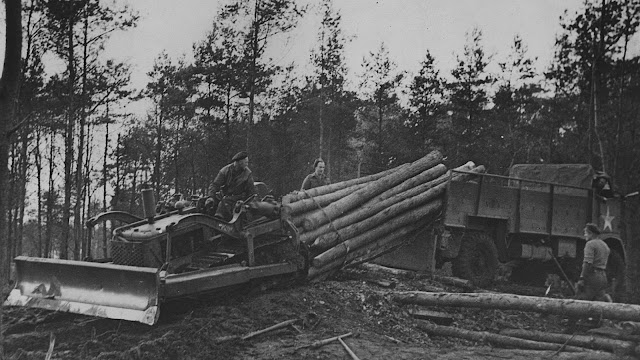 |
| Another Bedford Portee GS body being loaded with logs - Netherlands - 1944. |
 |
| Bedford Portee GS body leading a line with Dodge 3ton CMP truck and Chevy CMP 15 CWT 4x4 49th British Infantry Division (Polar Bears Butchers) Liberation of Utrecht- Netherland, May 1945. Notice the top of cabin made with wood and canvas. |
 |
| Another Bedford Portee GS body from 49th British Infantry Division (Polar Bears Butchers) Liberation of Utrecht- Netherland, May 1945. Notice the absence of the blast shield above the radiator. |
 |
| An Austin K5 Portee GS body, in RAF colors Somewhere in Holland, 1945. Notice the soft cabin and blast shield. |
 |
| Austin K5 Portee GS body with happy soldiers at rest. Notice the blast shield and Mickey Mouse cammo |
 |
| Same Austin K5 Portee GS body with soldiers, of the photo above, but in side view. Notice the GS body and Mickey Mouse cammo in the canvas. |
 |
| Panzerserra's warehouse... Too many (old...) kits |
 |
| Bedford Truck - Italeri (# 241) from 1984 - Oldie, but goodie!! |
This particular model don't have the 6 pdr. gun, but I had (on the other shelf) another pearl in store, waiting to be brought to life, on some dark and distant day ...
 |
Zvezda - 1996 |
 |
Ordnance QF 6 pdr Mk IV Anti Tank Gun + Mk 1A Carriage Riich Models - (#RV35018) |
When I decided to build this truck-destroyer, I had (and am having ...) a HUGE difficulty finding photographs and drawings about the Bedford 6 pr. gun portee. I found many photographs of Austins and CMP Fords labeled as Bedfords, but in reality, they were not. I found pictures of Bedfords portees rebuilt as GS, but with the "cargo bay" of the portee, almost nothing!!
I was almost thinking about giving up building the armed version and moving to the cargo versions (a little scratch does not hurt anyone ... quite the opposite !!), when I decided to ask on social media for help ...
A very good friend mine, Andrew Tomlinson (Thanks a lot, man!), told me about a documentary film about the Victory Parade in Tunis that he had watched and that he thought the film showed some Bedfords. I started digging on the Internet and after finding and watching the 20th May, 1943 Victory Parade on Gambetta Avenue in Tunis, from different sources and angles, I found this (notice at 2:40):
 |
| Bedford 6 pdr gun portee KIKI Hurrah!! |
At first, I thought the Bedfords were British (Indeed, by Jove!), but as I researched more and more, I discovered new scenes and new angles that allowed me to locate the Bedfords were British equipment used by the Free French. The flag on the KIKI radiator may now seem obvious, but that could be only a tribute ou a parade ornament...
 |
| Frame from another documentary, showing KIKI in the company of his sisters ... Vive la France !! |
Once again social media colleagues helped with links to research material and the Free French First Division was defined as the Unity to which KIKI belonged , correctly, historically.
 |
| Bedford 6 pdr gun portee KIKI with his sisters. Victory Parade on Gambetta Avenue - Tunis 20th May, 1943 Stéphane Escalant (Merci, mon ami...) sent me this photo. |
The problem now was to define what that stain on the vehicle door meant, which, in my opinion, could only be the emblem of the Unit to which KIKI belonged. I started putting together an infographic with the information I already had, because now I was REALLY decided to try to reproduce KIKI with my kit:
 |
| Details in KIKI... First impressions... |
In the first instance, details that I and many colleagues saw and that we could consider correct: Names (KIKI and PACIFI), census number (for now, I thought that was the number ...), color SAND (by deduction ... for now ..) and the main unit to which KIKI belonged (1ere Division Française Libre - 1ere DFL or 1st Free French Division).
With this material that the colleagues passed, I started to work with the emblems in an image editor that I use, stretching, deforming and smudging the badges until: BINGO !!!
 |
| Stretching and compressing badges, until you find an image similarity ... Done!! |
 |
| KIKI's right door - side view Notice the emblem and the right number (8, no 3...) Stéphane Escalant (again, many thanks) photo |
 |
| 1ere BIMP- metal emblem |
 |
| Notice the Bedford KIKI in Sand color and the Lorena Cross in the flag's radiator in red outlined in blue |
 |
| Final details in KIKI |
Therefore, Mesdames et Messieurs, with all the historical part solved, I will build the Bedford 6 pdr. gun portee KIKI belonging to the French Free Forces, serving in Tunisia - 1943, with the 1st Free French Division - 1st Free French Brigade - 1st Navy and Pacific Infantry Battalion. I will try to reproduce this girl with the characteristics that she presented in the Victory Parade of 20th May, 1943, in Tunis.
Specs:
| Bedford QL 6 pr. gun portee | |
|---|---|
| Place of origin | United Kingdom |
| Service history | |
| Used by | British Armed Forces |
| Wars | WWII |
| Production history | |
| Manufacturer | Bedford - Vauxhall |
| Produced | 1941-1943 |
| No. built | 2.406 ordered 388 completed as gun portee |
| Specifications | |
| Mass | 3,277 kg (empty) 7.100 kg ( full loaded) |
| Length | 5.800mm |
| Width | 2.450mm |
| Height | 3.054mm - 2.148mm |
| Crew | 6 |
| Main gun Armour | Ordnance QF 6-pounder gun 12mm - front gun shield 12mm - side shields |
| Engine | Bedford, 6 cyl -3,519 cc petrol - 72 hp |
| Payload capacity | 3 tons |
| Suspension Maximum speed | Wheel, 4x4 70 km/h |
Operational range | 250 km |
Kits:
As I explained before and above, the kits used will be the Biblical Bedford truck by Italeri and the 6pdr. AT gun Mk I by Zvezda, all contemporaries of Methuselah !! Hallelujah!! Kojak will be able to exercise all his magic !!
 |
| Kojak and the kits, in my empty workbench... |
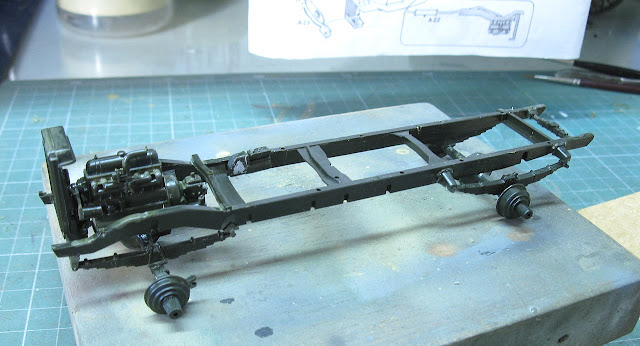 |
| Smooth and easy... |
 |
| Old school kit, with burrs and flashes, but a delight to build ... |
 |
| Kojak, I need more power...!! |
 |
| Warp speed, Captain!! |
 |
| Bedford wheels...Wonderful... no frills and no over-engineering ... they just work ... |
 |
| Time to build the cabin squaring everything ... |
 |
| A good sequence to build a perfect Bedford portee cabin |
 |
| And the cargo area. The platform is also well aligned and scanned ... |
 |
| Don't worry about pin-marks: they will be covered with ammo bins in the future ... |
 |
| Cabin in the chassis: soooo cute!!! |
 |
| Rear view. |
 |
| Increasing assembly rigidity with the cargo bed |
 |
| The girl is getting more and more beautiful !! |
 |
| The original water cans and the new ones with a little scratch... |
 |
| Much, much better!! |
 |
| The cans are half hidden, but I know they are better ... |
 |
| Well ... not so hidden ... They really do appear ... and they thank the small upgrade ... |
 |
| Time to install de ammo bins... |
 |
| Kojak is a wise guy!!! |
 |
| The girl, with her belly fully exposed ... This is kind of embarrassing ... |
 |
| She, now a little more behaved ... |
 |
| Right view |
 |
| Rear view ... Cab aligned and parallel to the cargo compartment. A construction with care. The bald guy is working well ... |
 |
| Some details are unbelievable ... I like old things, but this is too much ... Let's fix this ... |
 |
| The "chain" really was too much for my head ... after putting the gun on, let's see if I need to reproduce this in a more "real" way ... |
 |
| The construction is going well !!! Like the real KIKI, the windshield is positioned upright. |
 |
| Rear view - This plastic stains a lot with the glue. The construction aspect is just dirty !!! |
 |
| With the truck practically ready, let's peel the pineapple: Zvezda's QF 6 pdr. AT gun !! That promises !! |
 |
| Indeed, the kit is very old... Many burrs and injection marks, but with possibility of repair ... |
 |
| And some details that can be improved ... |
 |
| The gun, with some metal details made in scratch ... |
 |
| The gun ready for fire!! |
 |
| Testing the gun at your location. As in the photos, KIKI has his gun aimed at the aft fire position. |
 |
| The weapon occupies practically the entire cargo area ... |
 |
| Right view |
 |
| Left view |
 |
| Primmer in white (Tamiya) and yellow (AK) |
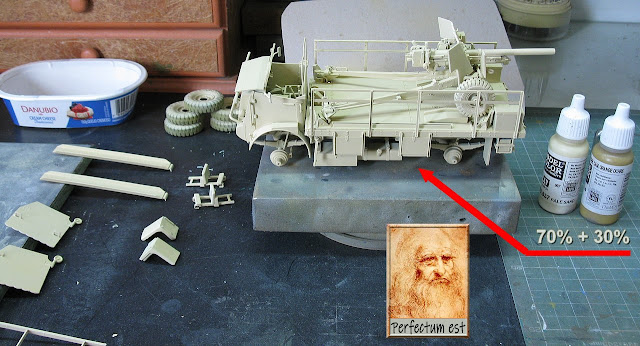 |
| My recipe for Sand color. Leonardo approves!! |
 |
| After the base color has dried, I will work with the tones ... Left view |
 |
| Right view |
 |
| Tones and subtones... Notice the spare wheel: nuts and bolts have been replaced by holes. |
 |
| Now, it's decal time!! |
 |
| Shot of my computer monitor. Notice the transparent decals and the white decal arts, in separated groups. |
 |
| The drawings printed in a basic A4 paper sheet. Notice that the French flag was cutted, for the test of position. |
 |
| Using water, I put the "decals" in position... So far, so good!! |
 |
| Perfect, for now ... the numbers no need a white background, because the base-color is very light ... |
 |
| Ops..Here are two mistakes; the emblem of the Free French and the numerals are a little too big for their positions. The dry-run is already justified ... |
 |
| Time to redo the drawings in question: shorten a row of numerals and the French emblem And I was forgetting the pennant ... Now, Leonardo is pleased!! |
 |
| Portions of cut decals, positioned next to the arts. |
 |
| "Covering" the arts with virgin decals ... Notice the adhesive tapes out of the impression areas... |
 |
| Sooo pretty!! KIKI was born, now!! transparent decals in position, sealed whit Pledge. |
 |
| Kojak is so proud!! 1st Navy and Pacific Infantry Battalion emblem in the doors position... |
 |
| Starting the weathering... |
 |
| Washes and dry-brush... |
 |
| As I am trying to reproduce KIKI in his Victory Parade, I will not overdo the aging ... |
 |
| The same criterion with the 6 pdr. AT gun |
 |
| Discreetly worn ... almost immaculate! |
 |
| In metal, the chains are much better ... |
 |
| The 6 pdr. in "rear-fire" position... left view. Notice that KIKI is wearing his shoes for the first time ... |
 |
| The 6 pdr. in "rear-fire" position... right view |
 |
| We have to find a position for the ramps and the ladder ... |
 |
| First, the ramps; under the gun, on the long axis of the cannon (red arrows) , in a position that is easily accessible and does not interfere with the action of the gunners ... Monique thought it was perfect !!! The chains embrace the ramps and hold the cannon, close to the "ground" (green arrow). |
 |
| The terminal portions of the ramps are supported by a wooden board, to avoid friction and unnecessary noise. Kojak is a forewarned guy ... |
 |
| The ladder, now... It will be tied to the outer portion of the right side rail of the cargo area. |
 |
| Notice the extra-armour plates in the sides of the gun... The two seats for the gunners follow the pattern of the photos of the Parade, that is, they are in the forward part of the cargo area. |
 |
| The girl, almost ready for final details... |
 |
| See in the attach image: KIKI has the left "ear" (orange arrow), but not the right "ear' (light blue arrow) |
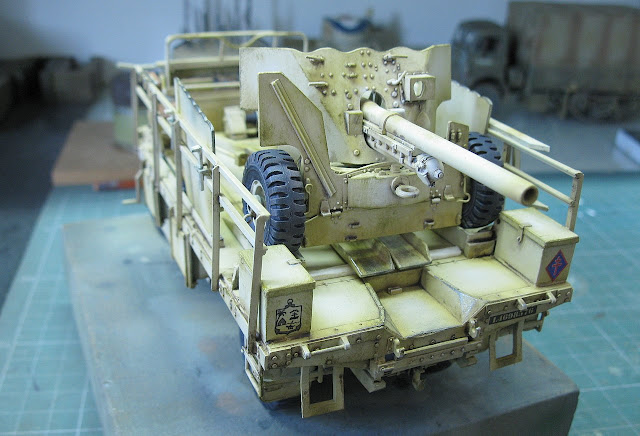 |
| Rear view... |
 |
| Right view. Again, the results of our cabin's surgery (red arrows)... Much better!! |
 |
New decals, ready for action. The sequence is:
|
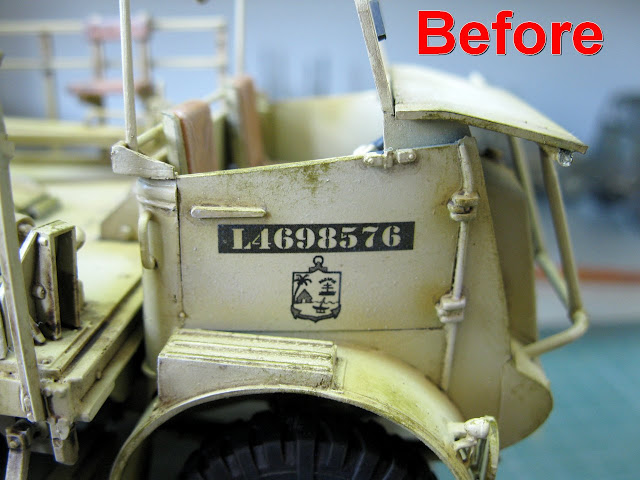 |
| KIKI with no upgrade... Numbers in "sand"... |
 |
| After Pledge, the white decal. Notice the size: Slightly smaller than "colored" ... Enough to give the numbers a white background ... |
 |
| Same in the rear numbers... |
 |
| After the white background has dried, I apply the transparent decal on it. Wow !! Much, much better ... |
 |
| left side |
 |
| Now Kojak is happy !!! (and stop bothering me !!) |
 |
| An image is worth a thousand words!!! |
 |
| Tracing paper was cut to the correct size, with the edges of the paper folded and glued on the thread ... PVA glue will be applied with a brush to wrinkle and increase the strength of the paper |
 |
| The flag immediately after painting with Vallejo White color. The humidity of the painting wrinkles the flag more, but with drying, it returns almost 80% of its "smoothness", which is very good !! |
 |
| The Free French flag decal applied in the tracing paper. I used Pledge before and after to avoid silvering or bubbles. After Pledge's "sealing" dried, I applied a layer of flat varnish. |
 |
| The Free French flag in position. Notice the somewhat wrinkled aspect I got ... Kojak was very satisfied .... |
- area on the paper painted in white and with a layer of Pledge
- application of the pennant decal over the paper
- drying and new Pledge layer
- drying and layer of flat varnish
- cutting the pennant
- gluing the pennant on the steel wire (mast on the side of the truck) with PVA glue. Easy!!!
 |
| Notice the pennant, whit the decal applied directly over (painted in white) tracing paper... |
 |
| Bedford 6 pdr. gun portee KIKI- French Free Forces 1st Free French Division - 1st Free French Brigade 1st Navy and Pacific Infantry Battalion. Victory Parade of 20th May -1943 - Tunis - Tunisia. |
 |
| Bedford 6 pdr. gun portee KIKI right side view |
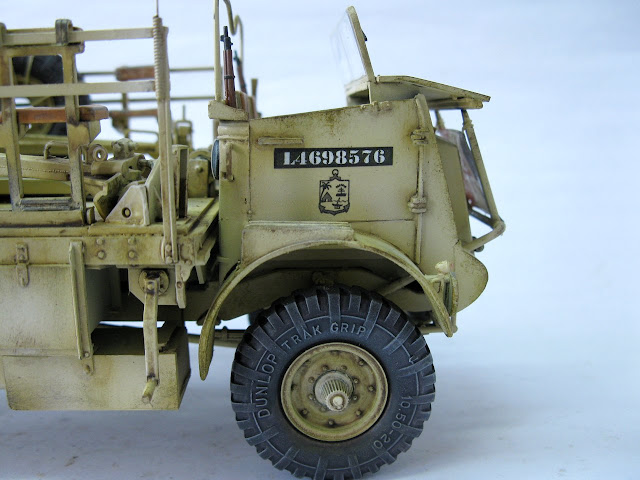 |
| KIKI, a Bedford 6 pdr. gun portee 1st Navy and Pacific Infantry Battalion emblem in close |
 |
| KIKI - Bedford 6 pdr. gun portee left side view |
 |
| Bedford 6 pdr. gun portee KIKI 3/4 front left view |
 |
| Bedford 6 pdr. gun portee KIKI with Kojak and Rover, the dog. |
 |
| Bedford 6 pdr. gun portee KIKI towing another 6 pdr. AT gun... A possible combination... |
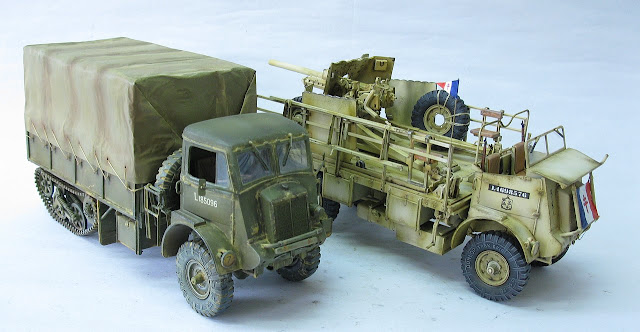 |
| Two Bedford girls, side by side: Bedford QL halftrack prototype and Bedford 6 pdr. gun portee KIKI |
 |
| KIKI - Bedford 6 pdr. gun portee and Bedford QL halftrack prototype |
 |
| Bedford 6 pdr. gun portee KIKI- French Free Forces 1st Free French Division - 1st Free French Brigade 1st Navy and Pacific Infantry Battalion. Victory Parade of 20th May -1943 - Tunis - Tunisia. |





















How, what a great job. Thanks for sharing history, and congratulations for the model.
ResponderExcluirManuel
Hi, Manuel!! thanks, my friend!! The Bunker is ours!! Big hug and take care!!!
ExcluirHi. Great model. I'm just about to start on this old kit. I prefer the look of the gun in the rear pointing position. I want to do a vehicle on the battlefield versus yours on parade. One question, would the overhead tilt tarp framework be always fitted on the in-battle version? It wouldn't need it for the parade version. I like it without the tarp frame like yours, but would it be wrong to leave it off for the battlefield? I realise it provides camouflage. Sorry for the long question. Neil
ResponderExcluirHi, Neil!!! Thanks man, for stopping by and writing!!!
ExcluirSo good to hear you're bringing this old girl to life!!! Yes...The combat versions are very creative and are my favorite, but when I saw these pictures, I couldn't resist... And the rear-pointing gun is really my favorite position. About the coverage, I'll give you an honest opinion: Never say Never and Never say Always when it comes to WWII!!! The use of a rear cover was not mandatory!!! If you were "Harry" in the African desert and the cover was torn and fluttering in the wind, interfering with your aim and even your camouflage, I don't think you would hesitate to rip it off!!! And the rods (without the canvas or camouflage net) would be nothing more than obstacles, increasing the profile of your vehicle, when it was in an ambush fire position, behind a dune (boged chassis type). If you like your vehicle without the frames, build it like this...IMHO, you wouldn't be wrong!!! And syphilis in the radical purists and rivet counters!!! LOL
Hugs, my friend!! Check back often!!!
Almost a year after your comment, I´m just about to start this model too. And I was pleasantly surprised someone had built this old kit again (and more, when it turns out that "someone" was none other than Panzerserra). Anyway, I would be delighted to know if you (Neil) finished it too...
ExcluirHi, Anonimous!!! Neil never wrote again, but I sincerely hope his girl was brought to light. And as for you, good luck...Even old kits manage to satisfy us a lot...and I dare say even more than modern and "pasteurized" models... Thanks for stopping by...and come back often.. .mainly with updates of your projects... Good modeling, my friend!!! Have fun!!!
Excluirbravo pour le travail de recherche historique pour trouver un sujet original, le résultat est magnifique, superbe.
ResponderExcluirmerci pour le partage en photos de la construction.
Salut, Matho... Merci beaucoup, mon ami. Merci beaucoup pour les mots d'encouragement. Revenez souvent... le Bunker est notre maison !!!
ExcluirFinally pulled this off the shelf for a quick build, as usual with vintage Italeri kits it was not very quick. This kit took me a full week to get to point that it is ready for paint. Typical for an Italeri kit of the era the parts fit is very vague and multiple test fitting is required. The front and rear leaf spring dampner/absorbers do not fit/attach where the instructions indicate and I used my best judgement and finally found a spot that seemed reasonable. There is a reason that you cannot find many photos of completed Italeri Bedford QL kits that are built, it is because most people probably give up during the assembly process or smashed the kit by stomping on it. Even with 50 years of scale model building this kit was sheer frustration and was not enjoyable to build. The dark green styrene is very hard and brittle making it time consuming to remove/sand the sprue attachment points, mold seams and numerous knock out marks. I actually had to take this thing to the kitchen sink and wash it after assembly was complete because it was covered in dust from all of the sanding! Now that it is done and primed it does look pretty good, but there are still some issues that I will know to change when I build this kit again.
ResponderExcluirCurt in KC
Yes, Curt... this kit is complicated, but the challenge is part of the fun, no doubt. The old kits were really hard work... Good luck with your girl, but I think that after all the setbacks, the end result is worth it, because the model looks really nice. Big hug and take care!!!
Excluir